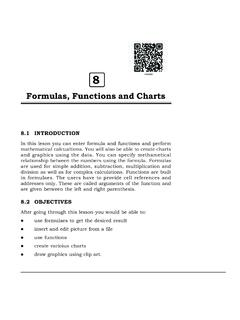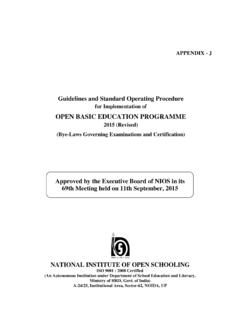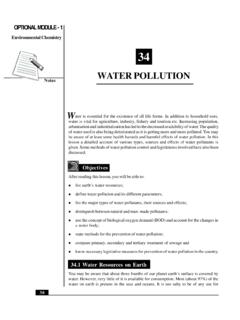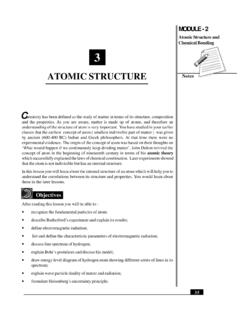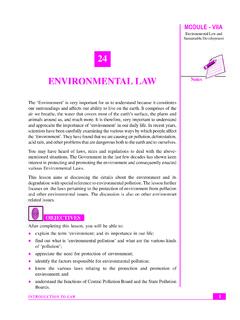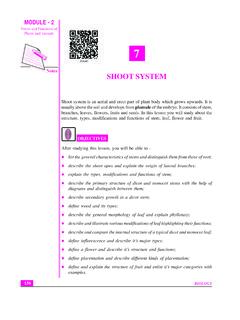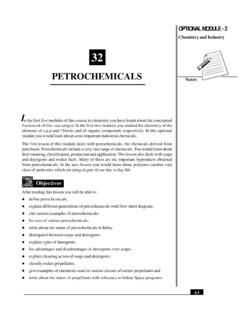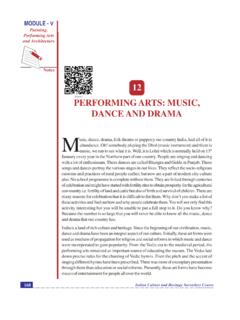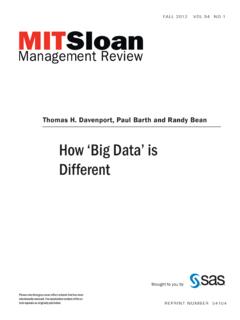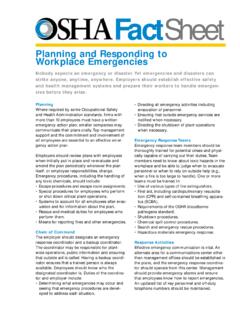Transcription of TYPES OF INFORMA TION SOURCES - National Institute of …
1 LIBRARY AND information SCIENCEMODULE - 2 INFORMATIONSOURCES 86 NotesTypes of information Sources6 TYPES OF INTRODUCTIONIn Lesson 5 you have learnt about different TYPES of information SOURCES , theirdevelopment and how they are organized based on their information contentsand this lesson you will learn in detail about each one of these SOURCES , their basicinformation content, utility and examples. You will also learn how to use themeffectively to provide services to the users. The Lesson will also deal withadvantages and limitations of information SOURCES in print as well as inelectronic OBJECTIVESA fter studying this lesson, you will be able to:- list various TYPES of information SOURCES ; explain the difference between periodicals and serials; journals andmagazines; and newspapers; discuss reports, standards and patents as SOURCES of information ; explain the role of secondary periodicals and bibliography in accessingprimary SOURCES of information ; distinguish between a book and a manuscript.
2 Explain the difference between a pamphlet and a book; describe a typical book and its parts;MODULE - 2 INFORMATIONSOURCES 87 LIBRARY AND information SCIENCEN otesTypes of information SOURCES categorize books on given parameters (content and volume); and discuss the importance of tertiary SOURCES of PRIMARY SOURCES OF INFORMATIONYou already know that primary SOURCES are those SOURCES which contain originalinformation. They include new raw data, new interpretation of previouslyknown facts or idea, any new observation or experiment, etc. Primary sourcesare of varied TYPES , large in number and are widely scattered.
3 Primary sourcesinclude periodicals, newspapers, technical reports, dissertations, conferencepapers, patents, standards, trade and product PeriodicalsA periodical is defined as a publication which is published with definiteperiodicity , weekly, fortnightly, monthly, or quarterly under the same title,and intended to be brought out indefinitely. Each issue is dated and consecutivelynumbered. All the issues in a volume have continuous pagination. A periodicalconsists of collection of articles contributed by different authors. Periodicalsare also called serial can be defined as any publication issued in successive parts whichis intended to be continued indefinitely.
4 Common TYPES of serials includeresearch periodicals, trade and business periodicals, newsletters, newspapers,popular magazines, almanacs and yearbooks, annual reviews, indexing andabstracting periodicals. Multivolume books and encyclopaedias are not serials,as they cease publication once the last volume of the series is information in periodicals is timely, current and up-to-date than informationin books. Periodicals are of many TYPES such as scholarly periodicals, trade andbusiness periodicals, popular periodicals and magazines. Scientific journalswere the first ones to appear on the scene. In this lesson you will study aboutfollowing periodicals:- Scholarly Periodicals; Trade and Business Periodicals; Popular Periodicals; Magazines; and E-JournalsLIBRARY AND information SCIENCEMODULE - 2 INFORMATIONSOURCES 88 NotesTypes of information SOURCES (a) Scholarly PeriodicalsScholarly periodicals are published by learned societies, R&D organizations,universities and some reputed commercial publishers.
5 These are better knownas journals which generally publish research findings and are peer of the rigorous evaluation process, these publications are also referredto as refereed or peer- reviewed journals. Each article in such journals becomesa permanent record of that subject. Some of the basic features of such journalsare given below. The purpose of a scholarly journal is to report original and significantresearch in a particular discipline. These journals are primary source ofinformation and also called primary periodicals. These periodicals are the best source of information on new or currenttopics.
6 Articles are written by researchers, professionals or experts in the articles are mostly technical in nature and cannot be understood byreaders who lack the subject background. These journals are meant for scholarly audience and are called scholarlyjournals. Normally, these journals do not carry any advertisements. Each issue is consecutively numbered and all issues in a volume havecontinuous pagination. A scholarly journal article often has an abstract (a descriptive summary ofthe article) before the main text of the article. Each article has the address of the author/s. Articles always cite their SOURCES in the form of bibliography or bibliographies contain references to other scholarly writings.
7 Indian Journal of Experimental Biology (Fig. ) is an example of a scholarlyperiodical. Started in 1963, it is published monthly by CSIR-NISCAIR. Besidesresearch articles, it publishes notes and reviews in areas of experimental latest issue published in January 2013 is Volume 51, issue number 1 withpages - 2 INFORMATIONSOURCES 89 LIBRARY AND information SCIENCEN otesTypes of information SOURCES Fig. Indian Journal of Experimental Biology(b) Trade and Business PeriodicalsTrade and business periodicals are published by trade organizations andcommercial publishers. These periodicals cover articles, news, trends and issues for specificbusiness and industry.
8 Authors can be professionals in the field or journalists working for thepublisher. Articles cover industry trends, new products or techniques. The journal alsocovers organizational news. There are lots of advertisements related to specific industry or trade. Indexto the advertisers is also included. The periodical is mostly published on glossy paper and has colourfulillustrations. Though the language of the articles tend to be related to terms specific toindustry or trade, the articles are written for general educated of trade and business periodicalIndian Textile JournalChemical Week Fig. AND information SCIENCEMODULE - 2 INFORMATIONSOURCES 90 NotesTypes of information SOURCES (c) Popular PeriodicalsPopular periodicals are devoted to particular subject area and contain articleson that subject written in simple language.
9 Popular periodicals are meant for general public who do not havespecialized knowledge of a particular subject. These are published to inform, educate and entertain the public The purpose of popular periodicals in areas of science and technology isto popularize science. These are published by R&D organizations, government departments andcommercial publishers. Articles are mostly short and sometimes do not contain of popular periodicals :Science Reporter (English, Monthly) (Fig. )Vigyan Pragati (Hindi, Monthly) (Fig. )Science ki- Dunya (Urdu, Quarterly) (Fig. )Above three periodicals are popular periodicals (also called Popular Magazines)published by CSIR- NISCAIR.
10 These journals publish popular science articleson contemporary science ReporterVigyan PragatiScience-ki-DunyaFig. (d) MagazinesThe magazines are published by newspapers and commercial publishers. Thesemagazines entertain, sell products and give practical information and/orpromote a view - 2 INFORMATIONSOURCES 91 LIBRARY AND information SCIENCEN otesTypes of information SOURCES Content of the magazines include information on popular personalities,news and general interest articles. Authors are journalists and freelance writers. Glossy covers and lots of colour illustrations and photographs distinguishthese magazines from others.
